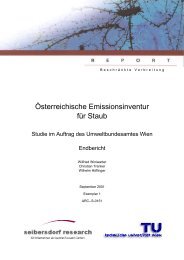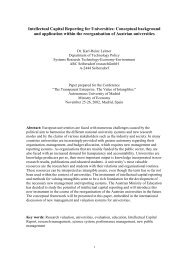ALPMON FINAL REPORT - ARC systems research
ALPMON FINAL REPORT - ARC systems research
ALPMON FINAL REPORT - ARC systems research
Create successful ePaper yourself
Turn your PDF publications into a flip-book with our unique Google optimized e-Paper software.
Contract ENV4-CT96-0359 <strong>ALPMON</strong><br />
The concept of object-wise data management is common in GIS <strong>systems</strong> like ArcView or the newest<br />
ArcInfo 8.0 release. Clicking on the object you will open the data base with the attributes assigned to this<br />
object. Looking for areas with specific properties, you will succeed starting a data base search following<br />
the rules of .sql language of relational data base <strong>systems</strong>.<br />
The result of object oriented image analysis is a data base with information on each object distinguished<br />
during the segmentation and classification process. This allows to identify objects with statistics changed<br />
between the observations by data base .sql queries and more, to quantify the changes. An image analysis<br />
system like eCognition, which additionally is able to use existing administrative or thematic boundaries<br />
from other investigations, has major advantages for specific purposes, like they occur for example in the<br />
forest administration, which is managing the forest on stand level, for biotope monitoring, a.s.o.<br />
Post-processing<br />
There is still a need for advanced post-classification techniques that can at least partially compete with<br />
human interpretation skills. While the spectral classification and the recognition of land cover types can<br />
be highly automated, the interpretation of spatial context and the derivation of land use patterns is still<br />
a complex matter. Post-classification as applied in <strong>ALPMON</strong> is a first step towards rule based<br />
generalisation but is limited to simple spatial parameters. Recent developments, such as object based<br />
classification schemes or graph based representation, offer new answers to these questions, which<br />
become even more evident when the very high spatial resolution data will be used in the near future.<br />
Concerning landscape monitoring not only satellite image classification could be an automated way.<br />
Another possibility to get cheaper results in landscape monitoring is the automatic recognition of<br />
objects. This would have to be tested in future.<br />
Table 23 finally illustrates by way of example the improvements in algorithms and software which are<br />
expected to increase the accuracy and performance of the erosion risk assessment. Part of these<br />
parameters do also apply to other alpine applications.<br />
Table 23: Expected methodological improvements useful to erosion risk assessment<br />
Methodological<br />
Improvements<br />
Elimination of the overcorrections<br />
in topographic<br />
normalisation<br />
Unsupervised classification<br />
algorithm taking into account<br />
the Mahalanobis distance<br />
instead of the Euclidean<br />
distance (like ISODATA).<br />
Database containing the<br />
phenological calendars of the<br />
most common species in the<br />
study area, better if updated to<br />
the actual meteorological trend.<br />
Benefits<br />
� Improvement of the land cover accuracy. Reduction of<br />
manpower in revision of the classification.<br />
� Increase in discrimination of vegetation classes.<br />
� Helps in selecting the best acquisition dates for the satellite<br />
images.<br />
� Useful in interpretation of spectral signatures.<br />
Rock-falls risk sub-model. � Accounts for the mass movements over slopes deepest than<br />
45°. The sub-model should be integrated to the existing FSTAB.<br />
Model tuning support system � Should help the geologist not very expert in fuzzy set logic in the<br />
definition of the inference rules and the tuning of the<br />
membership functions.<br />
3.4.3 Needs from Users Point of View<br />
The inventory of actual vegetation coverage is considered as the starting point of a monitoring program to<br />
supervise local or regional changes due to global change effects. Applying the methods developed under<br />
<strong>ALPMON</strong> it will be possible to draw up an inventory of forest habitats, tree species, tree ages, stocking<br />
JR, RSDE, ALU, LMU, Seibersdorf, WSL 89




